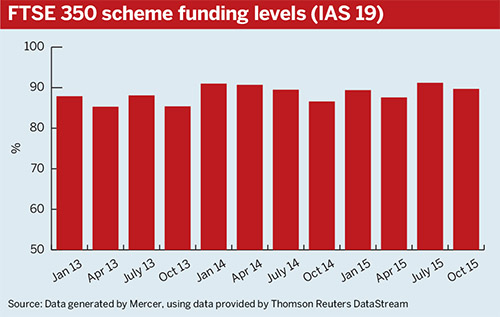From the blog: IAS accounting deficits belonging to defined benefit pension schemes have improved, but schemes should not get their hopes up about funding positions.
In its latest corporate bulletin, Punter Southall found that corporate bond yields across all terms increased by roughly 0.3 per cent in 2015 compared with a year earlier.
However, relying on the power of corporate bond yields to fill the funding gap in their pension schemes could be a risky strategy for DB pension scheme trustees.
Click here to read full blog post
In its latest corporate bulletin, Punter Southall found that corporate bond yields across all terms increased by roughly 0.3 per cent in 2015 compared with a year earlier.
If corporate bond yields rise, liabilities fall of course, because they are discounted against said corporate bond yields.
While most FTSE 350 companies would have used discount rates of between 3.5 per cent and 3.7 per cent in 2014, for 2015 Punter Southall expects this to be around 3.9 per cent.

But the bulletin warns that this improvement could be pulled down by poor asset returns: “Investment returns over the year to December 31 2015 have been unimpressive, with many asset classes having returned close to zero.”
It says the ‘spread’ between corporate bond and gilt yields is now bigger and “any improvement seen in the accounting position may therefore not translate into an improvement in other measures such as scheme funding”.
Scheme funding is indeed nothing to shout about, although it has improved very slightly.
Funding levels almost unchanged
JLT Employee Benefits puts FTSE 350 companies’ DB scheme deficits under IAS 19 at £70bn, making for a funding level of 88 per cent, while all UK private sector pension schemes’ funding level stood at 84 per cent at the end of December last year.
That is an improvement of one percentage point each on 2014, from 87 per cent and 83 per cent respectively.
Consultancy Mercer’s Pensions Risk Survey, covering around half of all UK pension scheme liabilities, shows IAS funding levels of FTSE 350 companies reached a high point in November last year, at 92 per cent, but have remained around the 90 per cent mark, with the exception of 2013, when the average funding level was nearer 85 per cent.
So relying on the power of corporate bond yields to fill the funding gap in their pension schemes could be a risky strategy for DB pension scheme trustees.
JLT predicts this lack of improvement in funding, the doubtful prospect of rapid interest rate rises in the UK and the outlook for growth and inflation could conspire to push companies towards liability management and risk transfer for their schemes. It will be interesting to see whether liability-driven investment and buy-ins/buyouts will indeed set the tone of 2016.














